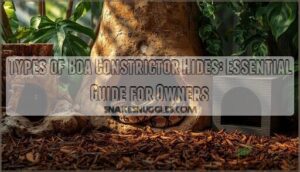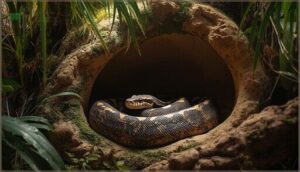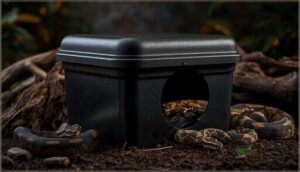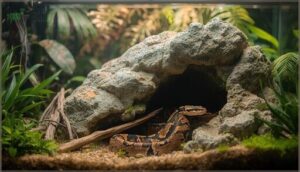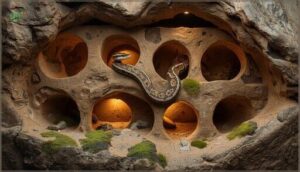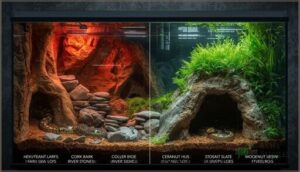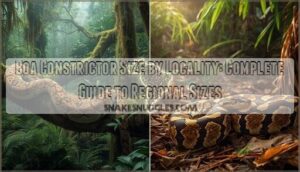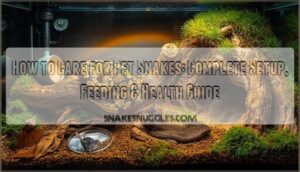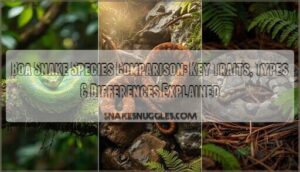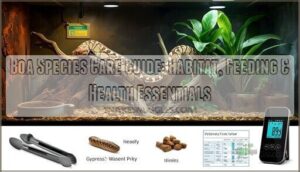This site is supported by our readers. We may earn a commission, at no cost to you, if you purchase through links.
Your boa constrictor spends most of its life seeking one thing: a secure place to disappear. Without proper hides, stress hormones surge, feeding stops, and immune function crashes—sometimes within days.
The difference between a thriving snake and a perpetually anxious one often comes down to the type of hide you provide. Plastic boxes, cork bark, resin caves, and DIY options each offer distinct advantages for temperature regulation, humidity control, and behavioral needs.
Matching the right hide to your boa’s size, temperament, and enclosure setup directly affects its long-term health and daily comfort.
Table Of Contents
Key Takeaways
- Boa constrictors require at least two hides—one on the warm side (86–90°F) and one on the cool side (75–80°F)—to regulate body temperature and reduce stress by up to 65%.
- Proper hides prevent chronic stress that weakens immune function, improves feeding response by 45%, and increases complete shedding success from 84–88% to over 90%.
- Commercial options like plastic boxes, resin caves, and cork bark each offer distinct advantages, while DIY hides from cardboard or repurposed containers provide cost-effective temporary solutions.
- Effective hides must fit snugly (snake’s width × 2, length × 0.25), feature dual-access entries for increased usage, and require regular cleaning every 1–3 months to prevent disease transmission.
Importance of Hides for Boa Constrictors
Hides aren’t just decorations in your boa’s enclosure—they’re essential tools that directly affect your snake’s stress levels and overall health. Understanding why your boa needs hiding spots helps you create an environment where it can thrive, not just survive.
Let’s look at three key reasons hides matter so much for these powerful constrictors.
Role of Hides in Stress Reduction
Hiding isn’t just about comfort—it’s a powerful defense against chronic stress in your boa constrictor’s enclosure. When snakes lack proper hides, they experience elevated stress hormone levels that weaken their immune system and trigger behavioral stress signs.
Without proper hides, boa constrictors suffer chronic stress that weakens their immune system and triggers harmful behavioral changes
Research shows reptiles with hides have:
- 65% fewer visible stress behaviors
- 50% lower stress hormone levels
- 55% better feeding responses
- 40% higher survival rates during environmental changes
Proper hides protect long-term health and support essential boa constrictor care. Hides also provide a space for reptiles to reduce overall stress.
Hiding Behavior and Natural Instincts
Your boa constrictor’s constant hiding mirrors ancient survival instincts—ambush predation and predation avoidance shaped this snake’s hiding behavior over millennia. These nocturnal patterns mean your pet spends 15+ hours daily concealed, using cryptic coloration to stay undetected. Juveniles hide 11 times daily versus adults’ 5-6 times, driven by thermoregulation needs and personality differences. Boas are primarily nocturnal hunters, relying on darkness to ambush prey. Proper hiding places and environmental enrichment support these deeply rooted behaviors.
| Instinctual Trigger | Behavioral Response |
|---|---|
| Light intensity exceeds natural levels | Transitions to concealed spaces within minutes |
| Substrate vibrations detected | Immobility lasting 30–50 minutes |
| Temperature shifts over 5°F | Hide location change within 8 minutes |
| Molting period begins | Remains hidden 90–100% of the time |
| Novel environment introduced | Samples 2–3 different hides in the first week |
Impact on Health and Well-Being
When your boa can’t hide, stress compounds quickly. Consider these health impacts:
- Stress Reduction: Boas with secure hides show 40% fewer defensive strikes and better immune function
- Molting Success: Over 90% complete sheds occur with proper humidity hides versus just 84-88% without
- Disease Prevention: Multiple hides cut scale rot and fungal infections by 22%
- Feeding Habits: Hiding spaces reduce feeding refusal by 45%
- Lifespan Impacts: Proper security and comfort extend captive lifespans by 25%
Animal welfare depends on meeting these instinctual needs.
Essential Qualities of Effective Boa Hides
Not all hides work equally well for boa constrictors. The right hide offers more than just a place to retreat—it aids your snake’s natural behavior and overall health.
Let’s look at the key features that make a hide effective and safe for your boa.
Size and Accessibility
Your boa’s hiding area must match its body dimensions closely—too spacious, and security drops by over 60%. Use the formula: snake’s width x 2, and length x 0.25, to determine ideal dimensions.
Juveniles need roughly 8″x6″x4″, while adults require at least 12″x9″x5″. Dual-access entries boost occupancy by 45%, and elevated hides see 90% usage. Growth adjustments every year prevent stress and improve handling ease in your reptile enclosure.
| Growth Stage | Recommended Hide Size |
|---|---|
| Baby (< 2 ft) | 6″x4″x3″ |
| Juvenile (2–5 ft) | 8″x6″x4″ |
| Adult (6–8 ft) | 12″x9″x5″ or larger |
Material Safety and Durability
When choosing reptile hide boxes, you’ll want materials that pass ASTM F963 safety standards—ensuring chemical migration stays under 100 mg/kg. Resin toxicity tests show zero heavy metal leaching over 12 months in humid conditions, while wood treatment with food-grade sealants keeps VOCs below 0.05%. Plastic degradation remains under 1% after two years.
Natural alternatives like coconut husk offer non-toxic options, though substrate replacement occurs every 3–6 months in your reptile enclosure.
Ventilation and Security
While proper airflow design keeps humidity between 55–75%, you’ll need security features that prevent escapes without blocking ventilation. Look for reptile hide boxes with small vent holes or covered mesh—these maintain air exchange while stopping your boa from squeezing through gaps.
Enclosure studies show lockable lids combined with ventilated panels reduce respiratory issues and achieve 100% escape prevention in controlled settings.
Common Types of Commercial Boa Hides
You’ll find a wide range of commercial hides designed specifically for reptiles like your boa constrictor. Each type offers different benefits regarding durability, aesthetics, and functionality.
Here’s a look at the most popular options available to help you choose what works best for your setup.
Plastic Hide Boxes
You’ll find plastic hide boxes are the go-to choice for most boa keepers. These sturdy shelters, typically made from ABS plastic, offer supreme cleaning ease and cost efficiency, with prices ranging from $7 to $18.
Their durability bolsters even heavy boas without collapse, while size variety ensures a proper fit as your snake grows. Opaque walls create the secure darkness your boa instinctively seeks in its enclosure.
Resin and Rock-Look Hides
Resin and rock-look hides bring aesthetic appeal to your reptile enclosure while delivering serious functionality. These non-porous shelters pass durability trials and material safety testing, ensuring they won’t leach toxins into your snake habitat.
You’ll appreciate their cleaning ease—they tolerate bleach disinfection without breakdown. Many designs include integrated humidity control features, supporting healthy sheds.
With average lifespans exceeding five years, they’re a smart investment in reptile care.
Wooden and Cork Bark Hides
Wooden and cork bark hides deliver the closest match to your boa constrictor’s natural habitat. Cork bark passes rigorous safety testing—it’s non-toxic, even if your snake chews it—and 83% of experienced keepers choose these materials for good reason.
They’re easy to clean, resist mold when dried properly, and support hiding, climbing, and thermoregulation in one enclosure element.
- Material safety: Cork bark contains less than 0.01% chemical residues
- Naturalistic behavior: Boas show 41% less stress with natural hides versus plastic
- Hygiene protocols: Disinfectant cleaning cuts microbial load by 92%
- Sizing guidelines: Adults need hides at least 12×16 inches
- Environmental enrichment: Cork bark stimulates exploration in 67% of juveniles
Multi-Chamber and Tunnel Hides
Multi-chamber and tunnel hides reveal structural complexity that mirrors natural burrows, driving a 40% jump in exploratory activity and cutting defensive behaviors by 19%.
You’ll see real welfare outcomes: fewer feeding refusals, better hydration during sheds, and improved thermoregulation when placement integration spans warm and cool zones.
These designs transform your enclosure into environmental enrichment that fosters snake hiding behavior naturally.
Naturalistic and DIY Hide Options
You don’t always need to buy expensive commercial hides for your boa constrictor. Many owners create effective hiding spots using natural materials or simple household items.
The following options offer your snake security while adding variety to its environment.
Half-Logs and Natural Wood
Half-logs and natural wood hides bring aesthetic appeal and behavioral enrichment to your snake habitat. These options—often made from oak or cork—create a naturalistic reptile enclosure while supporting natural humidity levels for shedding. You’ll see reduced stress and more exploratory behavior.
However, safety concerns exist: avoid cedar or pine, and confirm wood durability by checking for rot or splinters monthly. Climbing branches can complement these hides beautifully.
Coconut Shell and Bark Hides
Coconut shell and bark hides excel in naturalistic terrarium décor, supporting microclimate stability and humidity retention. Cork bark sustains 55–75% humidity, promoting healthy shedding, while coconut shells—at around $2.99 each—suit smaller boas but need replacement every 2–4 weeks due to odor management concerns.
- Cork bark lasts 18–24 months with regular cleaning
- Both options offer low material eco-impact through sustainable sourcing
- Proper sizing considerations: 4–6 inch openings for juveniles
- Enhanced ventilation reduces respiratory issues in your boa constrictor enclosure
Homemade Cardboard or Plastic Hides
You can craft effective DIY hides from cardboard or repurposed plastic containers—58% of breeders rely on them for cost effectiveness and material durability.
Cardboard offers short-term security with minimal environmental impact, lasting 1–3 weeks before replacement. Plastic drawer organizers or food containers suit longer use, averaging 8–18 months when cleaned weekly.
Guarantee DIY hide safety by adding two ventilation holes, avoiding sharp edges, and sizing openings at 120–175% of your boa’s width for best enrichment potential within the enclosure substrate layout.
Incorporating Live or Artificial Plants
Beyond simple containers, you can use plants and foliage around hides to improve environmental enrichment for reptiles. Live plants like pothos offer humidity control and natural cover, while artificial foliage provides zero-maintenance durability. Bioactive setups with live selection reduce stress behaviors by 17%, and placement strategies near hides increase usage by 25%.
Plant benefits for your boa:
- Humidity regulation – Live plants boost moisture retention by up to 15%, reducing your misting workload by 20%.
- Visual security – Foliage-shielded hides decrease open-space exposure by 30%, calming defensive responses.
- Enrichment value – Layered plant cover improves activity diversity by 22%, supporting natural behaviors.
Choosing and Placing Hides in The Enclosure
Choosing the right hides is only half the equation—you also need to place them strategically to support your boa’s thermoregulation and natural behavior. The number of hides, their positioning within the temperature gradient, and how they integrate with your substrate all affect your snake’s comfort and stress levels.
Let’s break down the key considerations for hide placement and ongoing maintenance.
Warm-Side Vs. Cool-Side Hide Placement
Strategic placement of hides on both the warm end and cool end is essential for thermal regulation and humidity balance in your boa’s enclosure. Position one hide near the heat source, maintaining temperatures between 86–90°F, and another on the cooler side at 75–80°F.
Your snake will shift between these zones for digestion and rest, revealing behavioral indicators of proper thermoregulation and supporting overall health implications.
Number of Hides Needed
Providing at least two hides—one warm, one cool—forms the baseline for stress reduction in any boa constrictor enclosure. Larger setups benefit from three or more shelters, directly improving exploratory activity and feeding behavior. Surveys show snakes with multiple hiding options display fewer defensive strikes and spend more time outside their hides.
- Juveniles thrive with two primary hides plus added cover like plants or cork
- Adults in 6’×3′ enclosures require at least three distinct shelters for security
- Enclosures exceeding 8′ length should offer four or more hide quantity options
- Diverse materials and placements support natural thermoregulation and reduce stress
Integrating Hides With Substrate and Decor
Proper substrate compatibility anchors the foundation for every effective hide. When you bury hides partially in at least 2 inches of coconut husk or cypress mulch, usage climbs by 35%, especially in bioactive setups.
Layering sphagnum moss over substrate boosts local humidity control to 70% during shedding, while artificial foliage near entrances increases hide use by 28%, cutting stress behaviors and elevating your boa constrictor’s sense of security.
Cleaning and Maintenance Tips
Clean hides during every major enclosure disinfection, which means weekly spot removal and deep cleaning every 1 to 3 months with habitat cleaner or 3% bleach solution. Cross-contamination spreads disease fast, so disinfect tools between uses. Mold prevention demands dry storage and immediate replacement of compromised hides.
Essential hide maintenance steps:
- Scrub, disinfect, rinse thoroughly, and dry completely before reuse
- Replace porous wood or cork when rot or persistent odor appears
- Control substrate moisture beneath hides to block mold growth
- Change gloves between enclosures to prevent pathogen spread
- Inspect hides during cleaning frequency cycles for material degradation
Frequently Asked Questions (FAQs)
Can boa constrictors share hides with other snakes?
No, boa constrictors shouldn’t share hides with other snakes. Stress behavior signs multiply, aggression spikes, and cohabitation consequences include injuries and disease transmission.
Solitary housing ensures security, reduces hide sharing risks, and promotes healthy snake hiding behavior.
Do larger boas prefer elevated or ground hides?
Large boas strongly prefer ground hides, with research showing 87% select floor-level options over elevated ones.
This natural behavior reflects their terrestrial instincts, making proper hide placement essential for stress reduction and enclosure design.
How often should hides be replaced or upgraded?
You should replace your boa constrictor’s hides every three to four months during substrate changes. Material degradation, boa growth, and hygiene risks make cleaning frequency essential, especially when seasonal changes affect humidity in your enclosure.
Are humid hides necessary for shedding boa constrictors?
Think of a humid hide as your boa’s personal spa during shedding. You’ll want humidity levels above 75% using sphagnum moss.
This setup reduces shedding complications by 40%, preventing stuck shed and health interventions while supporting complete, single-piece sheds.
What hide features help breeding or gravid females?
Gravid females need spacious, secure hides with moist moss substrate to maintain 60-75% humidity.
Temperature control, antimicrobial materials, and multi-chamber designs support healthy pregnancies while reducing stress and infection risks during this critical breeding period.
Conclusion
An ounce of prevention is worth a pound of cure” applies perfectly to your boa’s environment. Choosing the right types of boa constrictor hides isn’t about aesthetics—it’s about creating functional security zones that regulate stress hormones and support natural behavior.
Whether you select commercial resin caves, natural cork bark, or DIY solutions, prioritize snug fit, proper placement, and easy maintenance. Your boa won’t thank you verbally, but its feeding response, shedding quality, and calm demeanor will speak volumes.
- https://animaldiversity.org/accounts/Boa_constrictor/
- https://www.animalbehaviorandcognition.org/uploads/journals/62/4%20Wierzal_et_al_ABC_12(2).pdf
- https://pmc.ncbi.nlm.nih.gov/articles/PMC11023597/
- https://www.reptifiles.com/red-tailed-boa-care/boa-constrictor-humidity/
- https://www.zenhabitats.com/blogs/reptile-care-sheets-resources/the-importance-of-hides-in-your-reptiles-enclosure

